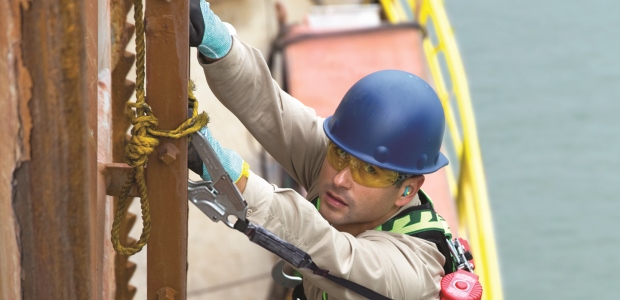
Rules of the Road
OSHA's regulation and consensus standards are guideposts for keeping your program on track.
- By Fred Elliott
- Nov 01, 2014
According to OSHA, thousands of people are blinded every year from preventable, work-related eye injuries—injuries that using eye and face protection properly could have prevented. Eye injuries cost more than $300 million annually in lost production time, medical expenses, and workers' compensation, according to the agency's online tool about eye and face protection (https://www.osha.gov/SLTC/etools/eyeandface/index.html).
The time-honored elements of the hierarchy of controls comes into play, of course, beginning with elimination at the optimal step, with engineering controls secondary and administrative controls and PPE—the focus of this article—after that.
You make decisions about the need for eye and face PPE and the types of PPE to purchase based on a hazard assessment. OSHA's 29 CFR 1910.132(d) says employers must carry out an assessment to determine whether hazards that necessitate the use of eye and face protection are present or are likely to be present before they assign PPE to employees.
These OSHA standards set mandatory requirements and offer compliance assistance for employers when selecting proper eye and face protection:
- 1910.132 - General requirements
- 1910.133 - General industry
- 1915.153 - Maritime
- 1926.102 - Construction
OSHA advises that your hazard assessment should determine employees' risk of exposure to eye and face hazards, including hazards that could be encountered in an emergency, and also that employers "should be aware of the possibility of multiple and simultaneous hazard exposures and be prepared to protect against the highest level of each hazard."
Additional Head & Face Protection Standards
The International Safety Equipment Association recently received American National Standards Institute approval for ANSI/ISEA Z89.1-2014, American National Standard for Industrial Head Protection. The standard was prepared by members of ISEA's Head Protection Group as a revision to the 2009 edition and was approved by a consensus review panel.
While its core performance requirements are unchanged, updates in the new version incorporate an optional preconditioning at higher temperatures of 60°C ± 2°C (140°F ± 3.6°F). This would offer added protection for users working in especially hot environments. Head protection meeting the product performance criteria after having been exposed to these higher temperatures will bear a unique mark: HL.
The revised standard provides flexibility and allows for the inclusion of emerging and state-of-the-art manufacturing materials for higher-temperature protection."ISEA's Head Protection Group established the optional preconditioning at higher temperatures as a parallel to the previous optional cold preconditioning performance criteria," said Joann Kline, chairman of the Head Protection Group and safety products, standards, and regulations leader for Kimberly-Clark Professional. "Workers are exposed to myriad head hazards on any given day, and we must be diligent in addressing various safety ranges in work environments to ensure user safety. ISEA's next step is to encourage and assist OSHA's recognition of this updated standard in its PPE regulations for head protection."
The other consensus standards of importance in this area include:
- ANSI/ISEA Z87.1-2010, American National Standard for Occupational and Educational Eye and Face Protection Devices. It establishes performance criteria and testing requirement for eye and face PPE, including eyewear, faceshields, welding helmets, and full facepiece respirators. The standard is organized according to the hazards workers may encounter--such as dust, impact, and droplet and splash--rather than according to PPE type.
- ANSI/ISEA Z358.1-2009, Emergency Eyewash and Shower Equipment. This standard addresses plumbed and self-contained emergency showers and emergency eyewash equipment. Just last month, OSHA’s Chicago North office cited a Michigan truck repair company and proposed penalties of $66,400 for allegedly failing to have an eyewash station readily accessible to workers were using hazardous chemicals at its Hillside, Ill., facility, in addition to failing to train workers on safe handling of the chemicals, according to the agency, which classified the five safety violations as repeat violations because a similar citation was filed in 2011 after an inspection of the facility.
For information about both of these standards or to order a copy, visit www.safetyequipment.org.
This article originally appeared in the November 2014 issue of Occupational Health & Safety.